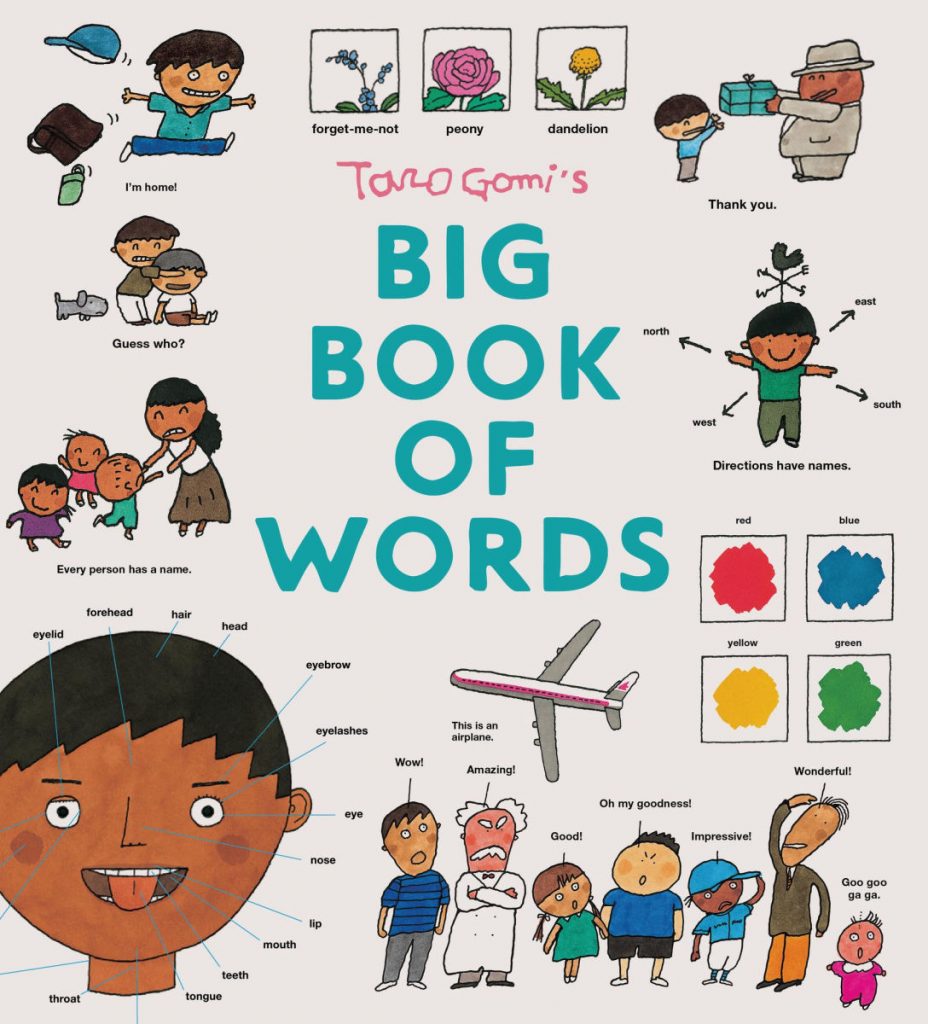 Taro Gomi’s Big Book of Words is an interactive and engaging picture dictionary that inspires curiosity and offers rich opportunities for literacy practices. Through playful and whimsical illustrations, English words and phrases are introduced in two sections: 1) Words and Phrases That Name Things and 2) Words and Phrases to Use in Conversation. Vocabulary is organized by familiar topics such as home, school, animals, transportation and the natural world. These are presented with creative and imaginative perspectives that invite children to see and use language in various ways. The text also supports concept building by encouraging children to make meaningful connections between words and the real-life contexts in which they are used. Continue reading
Taro Gomi’s Big Book of Words is an interactive and engaging picture dictionary that inspires curiosity and offers rich opportunities for literacy practices. Through playful and whimsical illustrations, English words and phrases are introduced in two sections: 1) Words and Phrases That Name Things and 2) Words and Phrases to Use in Conversation. Vocabulary is organized by familiar topics such as home, school, animals, transportation and the natural world. These are presented with creative and imaginative perspectives that invite children to see and use language in various ways. The text also supports concept building by encouraging children to make meaningful connections between words and the real-life contexts in which they are used. Continue reading
WOW Recommends
WOW Recommends: Book of the Month


WOW Recommends: Old as Stone, Hard as Rock of Humans & War
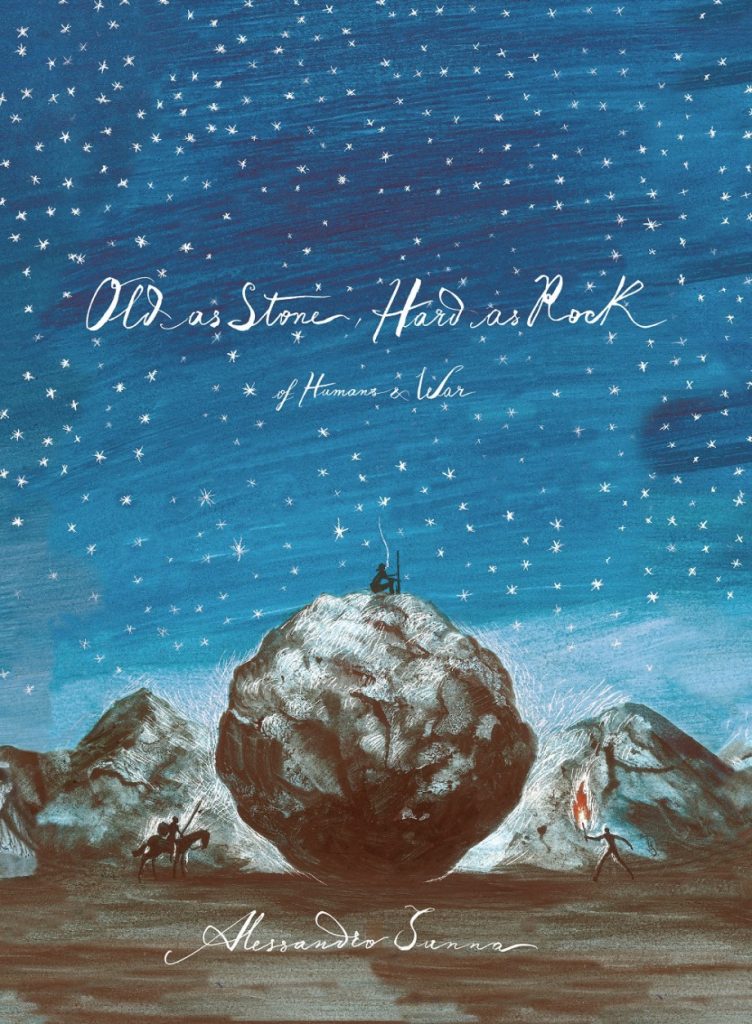 News of war around the world has been painful to hear and difficult to process. The unrelenting war in Ukraine, the utter devastation of Gaza, and the continuing civil war in the Sudan are daily reminders of the chaos, inhumanity and devastating consequences of war. When I came across the 170-page visual narrative on the history of war created by Alessandro Sanna, I was intrigued. The description printed on the inside flap of the front cover states that this book is “a visionary voyage in paint, shining a light on the unspeakable and on the twinned infinities of stone and stars.” Continue reading
News of war around the world has been painful to hear and difficult to process. The unrelenting war in Ukraine, the utter devastation of Gaza, and the continuing civil war in the Sudan are daily reminders of the chaos, inhumanity and devastating consequences of war. When I came across the 170-page visual narrative on the history of war created by Alessandro Sanna, I was intrigued. The description printed on the inside flap of the front cover states that this book is “a visionary voyage in paint, shining a light on the unspeakable and on the twinned infinities of stone and stars.” Continue reading

WOW Recommends: The Village Beyond the Mist
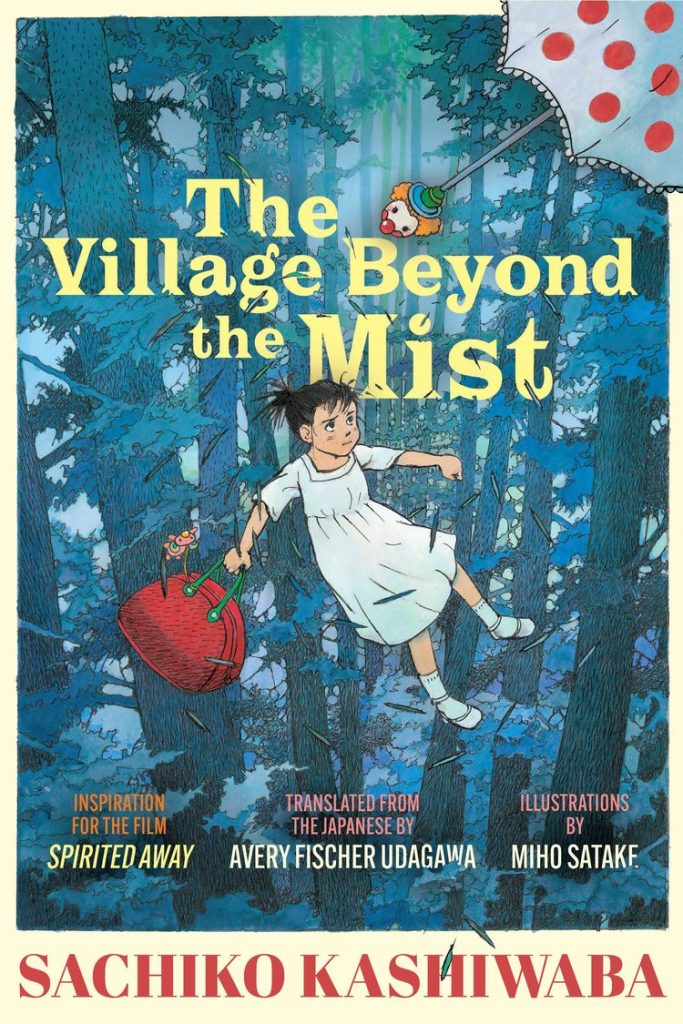 October is the month to shine for cosplayers and Trick-or-Treaters. One of the most popular costumes in the last two decades has been that of No-Face from the movie, Spirited Away. This 2001 fantasy/adventure movie was inspired by the book, The Village Beyond the Mist by Sachiko Kashiwaba. Although the movie draws inspiration from the book, the story and atmosphere vary significantly.
October is the month to shine for cosplayers and Trick-or-Treaters. One of the most popular costumes in the last two decades has been that of No-Face from the movie, Spirited Away. This 2001 fantasy/adventure movie was inspired by the book, The Village Beyond the Mist by Sachiko Kashiwaba. Although the movie draws inspiration from the book, the story and atmosphere vary significantly.
The middle grade novel begins with Lina setting off from home under direction by her father to find Misty Valley. With some effort and a little magic, she arrives at Picotto Hall. She’s told by the proprietor that she must work for her keep. Each week, Lina visits a new shopfront where she is presented with tasks to complete and fantastical people who need help. Any one of the wise and caring characters in The Village Beyond the Mist can serve for costuming inspiration as do the characters in Spirited Away. Continue reading

WOW Recommends: Outside Mom, Inside Mom
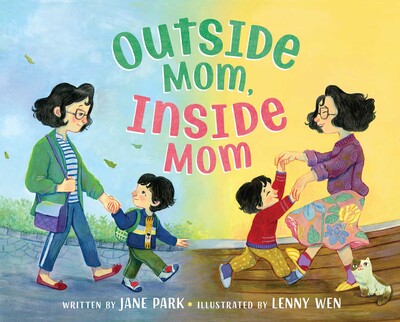 Outside Mom, Inside Mom captures the everyday experiences of a Korean American boy and his mother. In their daily lives, they navigate between two selves, the person they truly are and the version shaped by how others see them. Through the contrasting versions of how they act inside and outside the home, this book invites readers to reflect on what it means to be themselves and on how we see and understand others.
Outside Mom, Inside Mom captures the everyday experiences of a Korean American boy and his mother. In their daily lives, they navigate between two selves, the person they truly are and the version shaped by how others see them. Through the contrasting versions of how they act inside and outside the home, this book invites readers to reflect on what it means to be themselves and on how we see and understand others.
On the morning of the first day at a new school, both mother and son carefully choose their outfits, not based on what they like, but on how they might be seen by others. At school, the mother is quiet, reserved and avoids asking questions when speaking with the teachers. But once she returns home, she becomes a completely different person, filled with joy, curiosity and vibrant energy. While she is cautious and quiet in public, she is warm and lively at home. This contrast illustrates the tension between an authentic sense of self and the constant awareness of how one is perceived by others, a dynamic that often shapes how immigrants navigate the struggles and challenges of everyday life. Continue reading

WOW Recommends: Being Home
 Being Home is a contemporary story of a young Cherokee girl making the move from her current house in the city back to her ancestorial lands. Life in the city is chaotic and lacks the rhythm, family and natural surroundings of “home.” The young girl is ready to return home to the land of her people and Native culture. When moving day comes, the girl joyfully tells her old home good-bye and draws out her journey to her new home where she is greeted by relatives eager to help the family settle. When the move is done, the family gathers for a feast, the children play and explore their natural surroundings and the girl comes to “love the rhythm of being home.” Continue reading
Being Home is a contemporary story of a young Cherokee girl making the move from her current house in the city back to her ancestorial lands. Life in the city is chaotic and lacks the rhythm, family and natural surroundings of “home.” The young girl is ready to return home to the land of her people and Native culture. When moving day comes, the girl joyfully tells her old home good-bye and draws out her journey to her new home where she is greeted by relatives eager to help the family settle. When the move is done, the family gathers for a feast, the children play and explore their natural surroundings and the girl comes to “love the rhythm of being home.” Continue reading

WOW Recommends: Jella Lepman and Her Library of Dreams
 Jella Lepman and Her Library of Dreams: The Woman Who Rescued a Generation of Children and Founded the World’s Largest Children’s Library is by award winning author Katherine Paterson. This book is a biography of Lepman whose vision and dedicated efforts set up exhibits and later libraries for German children after World War II. Paterson starts with a short description of Lepman’s early years growing up in Germany with a Jewish family from her birth in 1891. Later, when Lepman was widowed with two young children, she found work as a journalist and then became the first woman editor of a liberal, German newspaper. When Hitler took power, promising to “make Germany great again,” she lost her job because she was Jewish. She was able escaped with her children to England where she eventually found work with the BBC, became an author and started a magazine. Continue reading
Jella Lepman and Her Library of Dreams: The Woman Who Rescued a Generation of Children and Founded the World’s Largest Children’s Library is by award winning author Katherine Paterson. This book is a biography of Lepman whose vision and dedicated efforts set up exhibits and later libraries for German children after World War II. Paterson starts with a short description of Lepman’s early years growing up in Germany with a Jewish family from her birth in 1891. Later, when Lepman was widowed with two young children, she found work as a journalist and then became the first woman editor of a liberal, German newspaper. When Hitler took power, promising to “make Germany great again,” she lost her job because she was Jewish. She was able escaped with her children to England where she eventually found work with the BBC, became an author and started a magazine. Continue reading

WOW Recommends: A Wolf Called Fire
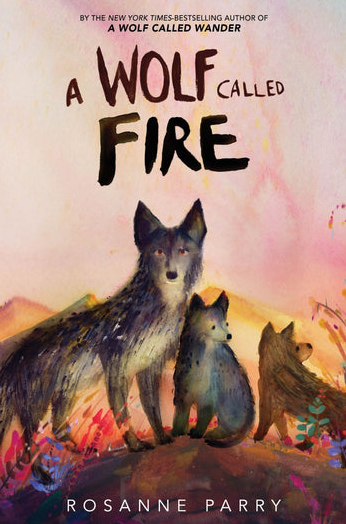 Warm is the smallest pup in the litter, but he is also the most observant. He watches. He watches his stronger and faster litter mates vie for a place in the pack while he is content to stay with the delta wolves who teach and care for the youngsters. Warm learns to listen and to smell while observing the happenings around him. Warm eventually becomes the encourager and the heart of the pack even as his siblings seem to outgrow him. But Warm is content not to be the next alpha male and starts to care for the newest litter once those pups arrive. And it is when the pack is attacked by the more aggressive “ice wolf” pack that Warm proves his loyalty to his family by heeding his mother’s directive and leading the newest litter away from the fray. Once safe from the conflict, however, Warm is confronted with not only the loss of his wolf family, but also the responsibility of taking care of and teaching the newest members of his pack. A Wolf Called Fire is the story of Warm and his rise to leadership. Based on one of the wolves in Yellowstone, readers will be captivated by the life of Warm and how he earns the name Fire. Continue reading
Warm is the smallest pup in the litter, but he is also the most observant. He watches. He watches his stronger and faster litter mates vie for a place in the pack while he is content to stay with the delta wolves who teach and care for the youngsters. Warm learns to listen and to smell while observing the happenings around him. Warm eventually becomes the encourager and the heart of the pack even as his siblings seem to outgrow him. But Warm is content not to be the next alpha male and starts to care for the newest litter once those pups arrive. And it is when the pack is attacked by the more aggressive “ice wolf” pack that Warm proves his loyalty to his family by heeding his mother’s directive and leading the newest litter away from the fray. Once safe from the conflict, however, Warm is confronted with not only the loss of his wolf family, but also the responsibility of taking care of and teaching the newest members of his pack. A Wolf Called Fire is the story of Warm and his rise to leadership. Based on one of the wolves in Yellowstone, readers will be captivated by the life of Warm and how he earns the name Fire. Continue reading

WOW Recommends: Oasis
 In this post-apocalyptic graphic novel, JieJie and her little brother DiDi make their way through a desolate desert landscape to reach an isolated telephone booth, their only contact with their mother who works tirelessly in a factory in the domed city of Oasis.
In this post-apocalyptic graphic novel, JieJie and her little brother DiDi make their way through a desolate desert landscape to reach an isolated telephone booth, their only contact with their mother who works tirelessly in a factory in the domed city of Oasis.
Their days are filled with surviving sandstorms and scavenging for food and water until they find an obsolete robot abandoned in a junkyard. They piece the robot together and activate its mother mode, gradually developing a loving relationship. When their worried mother travels to visit them in the desert, she initially rejects the robot mother. Her children persuade her that they can form a family and create a future together, rejecting the technological tyranny of Oasis. Continue reading

WOW Recommends: Buffalo Dreamer
 Buffalo Dreamer by Violet Duncan is a middle grade novel that confronts the painful and traumatic history of the Indigenous residential school system. Duncan, a member of the Plains Cree and Taino from Kehewin Cree Nation, addresses not only the horrors of the past, but also the resilience and strength of Indigenous communities who persevered through this painful history and found ways to maintain both their culture and identity. Sharing this history is very personal to Duncan whose father, grandparents, aunts and uncles were all survivors of the residential school system, Sixties Scoop and Indian Day Schools. Duncan states that she too is a survivor. Continue reading
Buffalo Dreamer by Violet Duncan is a middle grade novel that confronts the painful and traumatic history of the Indigenous residential school system. Duncan, a member of the Plains Cree and Taino from Kehewin Cree Nation, addresses not only the horrors of the past, but also the resilience and strength of Indigenous communities who persevered through this painful history and found ways to maintain both their culture and identity. Sharing this history is very personal to Duncan whose father, grandparents, aunts and uncles were all survivors of the residential school system, Sixties Scoop and Indian Day Schools. Duncan states that she too is a survivor. Continue reading

WOW Recommends: Looking for Smoke
 Looking for Smoke is K.A. Cobell’s debut novel for young adults. A member of the Blackfeet nation, Cobell takes on the crisis of Missing and Murdered Indigenous Women (MMIW) that haunt the Indigenous nations within the western USA. As Geraldine, the grandmother of one of the missing/murdered notes, “If you want to get away with murder, do it on an Indian reservation” (p, 39). Told through the perspective of four teens, the novel focuses on the teen’s reactions to one missing girl and another murdered girl who they knew intimately as either a friend or relative. In connection to the story of the missing or murdered young women, the novel includes issues of identity, drug-usage, poverty, and family dynamics that are part of these young people’s lives. It also addresses the pride of community and tradition that allow for a well-rounded sense of people and place. Continue reading
Looking for Smoke is K.A. Cobell’s debut novel for young adults. A member of the Blackfeet nation, Cobell takes on the crisis of Missing and Murdered Indigenous Women (MMIW) that haunt the Indigenous nations within the western USA. As Geraldine, the grandmother of one of the missing/murdered notes, “If you want to get away with murder, do it on an Indian reservation” (p, 39). Told through the perspective of four teens, the novel focuses on the teen’s reactions to one missing girl and another murdered girl who they knew intimately as either a friend or relative. In connection to the story of the missing or murdered young women, the novel includes issues of identity, drug-usage, poverty, and family dynamics that are part of these young people’s lives. It also addresses the pride of community and tradition that allow for a well-rounded sense of people and place. Continue reading
